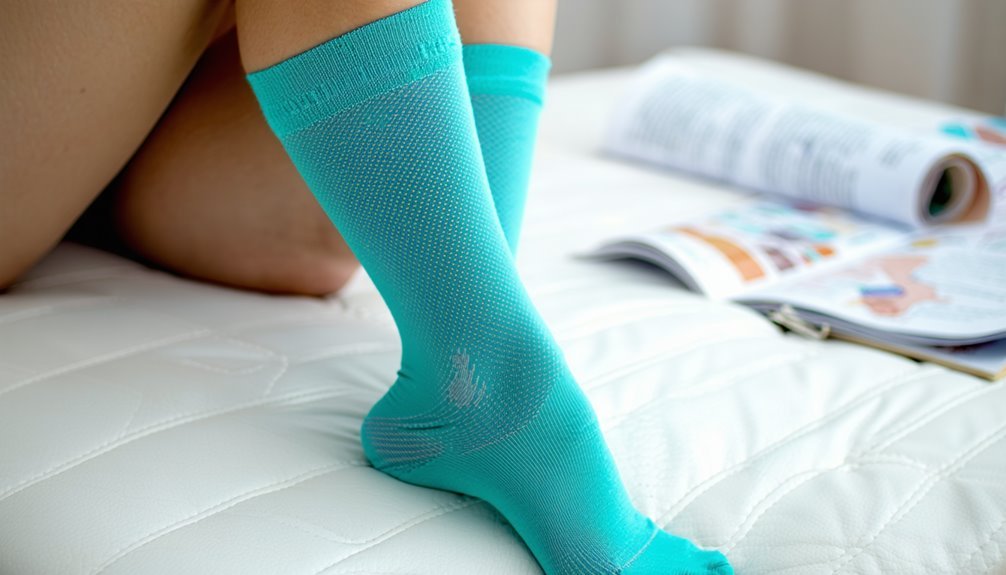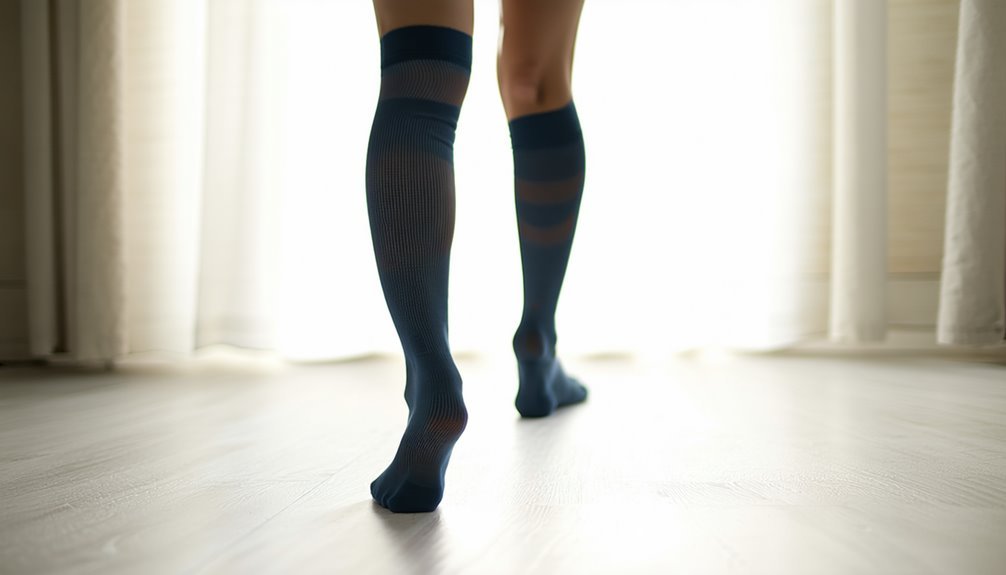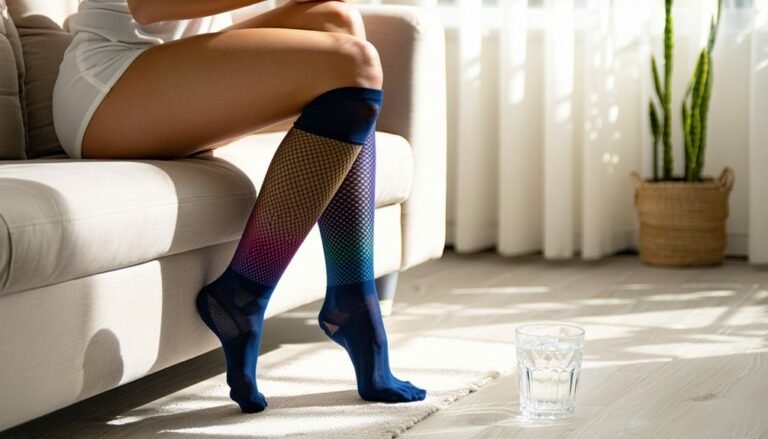Can Compression Socks Help Prevent Varicose Veins?
Compression socks can effectively help prevent varicose veins. They apply graduated pressure, primarily at the ankle, enhancing venous return and reducing venous pressure. This supports circulation, mitigating the risk of blood pooling. Clinical evidence underscores their efficacy, especially at compression levels of 15-20 mmHg to 30-40 mmHg for severe cases. The choice of durable, breathable materials like nylon and spandex guarantees both comfort and functionality. There's much more to explore on this topic.
Understanding Varicose Veins and Their Causes

Varicose veins, a common venous condition, occur when veins become enlarged, dilated, and overfilled with blood. You'll typically notice them as swollen, twisted veins, often visible under the skin, primarily in the legs. The primary causes of varicose veins include genetic predisposition, prolonged standing, obesity, and pregnancy. These factors increase venous pressure, compromising valve function and leading to blood pooling.
Symptoms of varicose veins aren't just cosmetic; they can include aching pain, heaviness, and swelling in the affected limbs. If left unmanaged, varicose veins can lead to complications like venous ulcers or thrombophlebitis. Addressing these symptoms early is essential for maintaining your venous health and ensuring safe, effective management of this condition. Always consult with a healthcare professional for tailored advice.
The Role of Compression Therapy in Circulation
Compression therapy, an essential component in managing venous disorders, enhances circulation by applying controlled pressure to the lower limbs. This pressure gradient supports venous health by promoting efficient blood flow back toward your heart, reducing the risk of venous pooling and subsequent complications. Clinical evidence underscores the efficacy of compression therapy in improving hemodynamics, thereby alleviating symptoms associated with venous insufficiency.
When you employ compression therapy, you're proactively supporting your venous system's integrity. The external pressure applied helps decrease venous diameter, increasing blood flow velocity and improving overall circulatory function. For individuals with a predisposition to venous disorders, this intervention acts as a preventative measure, ensuring your safety by mitigating potential risks associated with impaired circulation. Engage in this safe, evidence-based approach to promote ideal vascular health.
How Compression Socks Work
One of the key mechanisms through which compression socks function is by exerting graduated pressure along the leg, with the highest pressure at the ankle gradually decreasing up the calf. This graduated compression enhances venous return, consequently reducing venous pressure and preventing venous stasis. When you're selecting compression socks, understanding compression levels is vital. They are typically measured in millimeters of mercury (mmHg), with varying levels designated for different clinical needs. Sock materials are engineered to provide ideal elasticity and durability, ensuring consistent pressure application. Materials like nylon and spandex are commonly used for their elasticity and moisture-wicking properties, contributing to user comfort. By maintaining appropriate compression levels, these socks effectively support venous health and offer a non-invasive method for varicose vein prevention.
Evaluating the Effectiveness of Compression Socks

How can you determine the effectiveness of compression socks in managing varicose veins? First, assess the compression levels, typically measured in millimeters of mercury (mmHg). Clinical studies indicate that graduated compression, ranging from 15-20 mmHg to 20-30 mmHg, aids in reducing venous pressure and improving blood circulation. Evidence suggests socks with higher compression levels are more effective for severe cases. Second, evaluate sock materials. Materials such as nylon, spandex, or rubber are vital for elasticity and durability, ensuring consistent pressure application. Research demonstrates that these materials support patient adherence due to comfort and breathability. Regularly monitor symptom improvement, such as reduced leg swelling and discomfort, to gauge effectiveness. For best results, follow clinical guidelines and consult healthcare providers.
Tips for Choosing the Right Compression Socks
Understanding the effectiveness of compression socks in managing varicose veins paves the way for informed selection. When choosing socks, consider compression levels—measured in mmHg—appropriate for your condition. Mild levels (15-20 mmHg) suit mild symptoms, while moderate (20-30 mmHg) and firm (30-40 mmHg) cater to more severe issues. Sock materials should offer breathability and durability, enhancing comfort and wearability. Opt for materials like nylon, spandex, or lycra, which provide sufficient elasticity and moisture-wicking properties.
| Compression Level | Recommended Use |
|---|---|
| 15-20 mmHg | Mild symptoms, preventive care |
| 20-30 mmHg | Moderate varicose veins |
| 30-40 mmHg | Severe varicose veins |
Ensure proper fit to avoid constriction. Consulting healthcare professionals for personalized recommendations enhances safety and efficacy in your selection process.
Frequently Asked Questions
Can Compression Socks Relieve Pain From Existing Varicose Veins?
You might experience pain relief from varicose veins by wearing compression socks. They enhance blood circulation, reducing discomfort. Clinical studies indicate their effectiveness in managing symptoms, providing a non-invasive option that prioritizes your safety and vascular health.
Are There Any Side Effects of Wearing Compression Socks?
Wearing compression socks with improper sock fit may cause potential discomfort, including skin irritation or restricted circulation. It's essential to select the correct size and compression level, as evidence suggests that well-fitted socks enhance comfort and safety.
How Long Should Compression Socks Be Worn Daily?
You should wear compression socks for 6-8 hours daily, ensuring a proper fit to optimize venous return and minimize discomfort. Evidence indicates this duration effectively supports circulation while maintaining safety. Consult a healthcare professional for personalized guidance.
Can Pregnant Women Safely Use Compression Socks?
You're in luck! Compression socks are the superheroes of pregnancy, offering amazing benefits. Following safety guidelines, they're generally safe and can enhance circulation, reducing swelling. Always consult your healthcare provider to guarantee maximum safety during pregnancy.
Do Compression Socks Come in Different Styles and Colors?
Compression socks come in various styles and color options, ensuring you find a suitable choice for your needs. Clinical evidence supports their efficacy, and their diverse selections cater to both aesthetic preferences and therapeutic requirements, enhancing safety.







